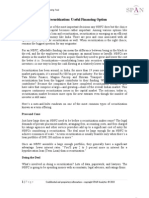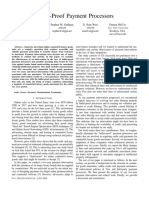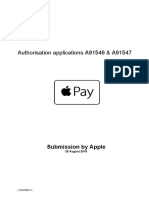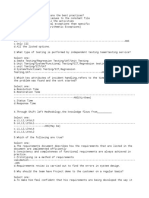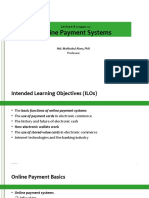THE ART OF APP DESIGN
Beauty made at your fingertips
Abstract
An analysis on making apps and making
them better.
Brendan Chong
CLC 11
Student Number:MR.785285
KOSHMAN
�Art of App Design: Brendan Chong
As the world of 21st century technology continues to change drastically, more consumers look
for portable, efficient and utile devices for the future. In 2016, Stats Canada surveyed 19,609
individuals and found “91% of Canadians aged 15 and older used the Internet at least a few times
during the month preceding the survey...The overwhelming majority of 15- to 34-year-olds
(94%) reported owning a phone”(Statistics Canada, 2016). There is no doubt the world has
become more connected than ever. Similarly, This spike can lead one to believe that more will be
done to satisfy the need for internet devices in the near future and does not seem to slow as sales
reach unprecedented rates. The development of apps is an important aspect to complementing
these portable devices.
An app, short for “application”, is another name for a computer software program. It is normally
associated with programs that run on mobile devices, such as Smartphones or Tablets. They
stand to improve business, social, entertainment, and other experiences. From drawing and
design to online shopping, apps are the personality of your devices.
The early days of computer programming required typing in number by number, and transferring
data on floppy discs. Today developers use advanced platforms to build user friendly apps and
are specially programmed for the different experiences. Finding out which platform suits one
most can lead amateurs to becoming experienced app developers in no time. The hope of this
paper is to learn where and how exactly apps are engineered, including a look at a few
platforms.
App design is not just about inserting lines of code to make something clickable. The bigger
picture is about finding out what apps can do for the customer. Developers look to code a full on
1
�Art of App Design: Brendan Chong
experience making apps simple yet elegant. Discussing criteria and useful traits of an app will
create a more marketable and effective program.
Of the many categories apps are used for, entertainment is one of the biggest and is a huge
money-making industry. For example, Supercell, founders of Clash of Clans in 2017 “earned a
profit of $810 million on revenues of $2.029 billion in 2017” (Takahashi D., 2018). This section
appeals to all ages and gives users an addicting and fun experience. To create a successful
entertainment app, one must pinpoint what all successful video game apps have in common and
look at where feelings are generated while playing. We can then understand certain elements and
mechanics associated with such.
An app cannot be launched successfully without knowing the market. Trends and surveys will
help in calculating the success and sales of the apps. It also shows what does well, and what does
not. Specifically, knowing preferred playstyles mobile gamers enjoy will pinpoint how an
entertainment app should feel. This research will reveal trends that appeal to the gaming market.
As the world searches for package sized capabilities, apps are becoming more essential to this
day and age. Developers need to be aware of how to code one and its main characteristics which
will provide an awarding outcome and user friendly experience. To focus on a gaming app
requires a set of these traits and mobile appeal. When exploring these two concepts, one will
have an idea on how to make their own successful app for the entertainment market.
App development can start with any rough idea, from a fun concept to making life easier. The
Developer’s goal is to then connect their idea by researching the target audience, the goal it aims
to achieve (more is explained for entertainment apps later on) and seeing that the idea has not
been trademarked by someone else already. To develop the idea, one must create an overview of
2
�Art of App Design: Brendan Chong
the app using a functional and technical documentation. A Functional Documentation describes
app features and how the app will function while a Technical Documentation outlines platforms,
human resources and other tools to make the app. These documents can later be used to pinpoint
problems after release. The app is then sketched on an app map which is “a web of intertwined
screens the app will interconnect to, including buttons, boxes, fields prepared with colors,
branding, buttons and more” (Devellano, M. 2017) for visual effect.
Developers can use a software platform for coding their app from scratch. There are many
different choices including HTML5, an Android platform. It comes with a plethora of tools and
shortcuts for new developers in making short, indie games. Swift, “the backbone of building IOS
apps” is another platform which began in September 2014 and uses code similar to English
words. It comes with an “Xcode checker” that checks the lines of code and closer defines the
code compared to HTML which limits mistakes in work and lets the app run more smoothly.
Both apps have a community base on StackOverFlow.com- an official Q&A community
programming site with over 5.2 mil users- and can be used to get answers to any programming
problem from other developers on the program.
After coding on platforms, the app can be beta tested where registered people get the chance to
play one's creations. While it may be fun, it is a crucial step in finding errors, bugs, etc., and
getting feedback on improving the overall experience. Using an iTunes Developer Account or
Google Play Developer Account - a profile for putting your apps under- the app can be submitted
to the Play Store or iTunes reviewer. It will almost instantly be approved or disapproved for
installation on the market.
3
�Art of App Design: Brendan Chong
A great app’s characteristics go beyond fancy graphics and catchy names. It first needs to be
simple and focus on one idea. Uber, for example, was primarily about getting your ride faster.
Without this focus, Uber would not have been nearly as successful as it is today. Another quality
of a great app is that they run smoothly. Savvyapps, former developer of award-winning apps
such as PBS for IOS knows that “all the main apps on a standard phone today don’t crash, aren’t
slow, and do what you expect them to do.” (Rhodes, W., 2015) An App transition, for example,
from one window to another happens almost instantaneously. Developers need to find ways to
minimize loading times by tweaking glitches in the beta stage or limiting amount of data to
process on a screen. Another example is Yahoo’s CEO, Marissa Mayer’s “two-tap rule”. All
apps on the top boards of Android and Apple charts alike use this rule. For example, “Flickr has
an opening screen, can navigate albums, check out groups, and more” (Carlson, N. 2015) all
available in between two touches or less. By limiting the extent of shuffling through features, we
appeal to the modern society that wants features fast and who is less tech savvy.
Arguably, reducing content may not always be the way to go. For example, “Homesnap, a
business app, shows the value of a house by taking a picture of it. Within seconds, tons of data is
crunched, and the expected price is returned...The wow moment of the app only really happens
when that occurs quickly” (Whitney, R. 2015). Downloaders need to feel like there's a gift that
does not cease to satisfy and therefore, it is important great apps reflect quantity and quality.
Finally, built in virality will also greatly affect the greatness of an app. For example, Facebook’s
messenger app has a chime whenever a new message has been sent to you. Small animations and
sounds lets users acknowledges that it is coming from a particular app and makes it stand out
from others.
4
�Art of App Design: Brendan Chong
The Entertainment category of apps takes advantage of our thinking and emotions. Playing
games trigger dopamine in the brain, “a neurochemical that affects learning processes and the
sensation of pleasure.” (Shvebish, G. 2014). The need for this sensation gets bigger the more we
play and is what makes games so hard to stop playing. Compared to other categories,
entertainment apps also appeal to subconscious levels, thinking which “makes fast, [irrational]
and more emotional decisions, sometimes without us being aware of it at all.” (Shvebish, G.
2014). This level gives us the thought that we are committed to playing “just one more level” and
combining it with dopamine make an addicting duo.
Developers have certain ways of triggering dopamine in game mechanics including a
“compulsion loop”. This concept is what encourages gamers to repeat an action the player has
performed. This is seen in Candy Crush as players match candies, obtain a score and repeat on a
harder level. Playing gets harder and senses of accomplishment get bigger and dopamine rushes
keeps the player always engaged. Another tactic is using “Hedonic adaptation”, an illusion and
psychological effect that the longer we wait for something, the more worth it will be when it
arrives. Clash of Clans uses real world time upgrade tower defenses. It starts at less than a
minute when first running the app but can take almost a week for a level 10 cannon during the
final stages of the game. The adaptation kicks in when gamers are pleased to find their upgrade
are done, giving them an unbeatable strength over their opponents.
One way to appeal to the subconscious is by giving users something to boast about in front of
others. An In-game Leaderboard for instance gives players competition and with it, a mentality
that one has a job to maintain being in a valuable spot or to outrank others. It makes the mind
jump to conclusions as if they are 10 points away from a competitor, they should spend 10 more
5
�Art of App Design: Brendan Chong
minutes to beat their score. Leaderboards create jealousy when being below someone or a
feeling of superiority on top another, joining the emotional connection and the addiction.
Mobile gaming is taking flight and is dominating the PC and console market today. “At the end
of 2017 this market made $46.1 billion, or 50% of all global games revenues compared to PC
gaming at 29.4 billion and Console at 33.5 billion. Mobile gaming is projected to reach over 50%
by 2020” (McDonald, E. 2018). IMGA Awards, the mobile gaming industry's leading showcase
for games such as Pokemon Go, believes it is “attributed to the rapid advancement of underlying
forces, such as smartphones, tablets, and mobile Internet networks” (IMGA Awards, 2017) Not
only is it cool to walk around with a piece of tech in hand, but the fact is society with cities and
huge companies has been sucked into business and economics. Whether it be at work or even
school, people do not have time to stop and sit around and having entertainment features in
hands is now essential.
The first trend for mobile gaming start with Free to play (F2P) apps. Users never want to pay a
dime for a downloadable game. However Developers are coming up with sneakier options such
as “Booster Packs and IAPs (in-app purchases) which have taken center stage as the primary
source of revenue.” A scheme of making money in 2017 called Gacha, allows users to make in-
game cash by playing. However, amounts are small and are given by chance inclining users to
pay instead. Mobile and social features are also huge since “The kids of today are growing up
with the Internet... So they will, therefore, expect the same opportunities to connect when it
comes to gaming.” (IMGA awards, 2017). Developers should therefore add Social gameplay or
real-time player-versus-player engagement. Finally, with the 2017 release of Virtual Reality and
Augmented Reality have opened a new level of PC and console gaming. However, due to the
6
�Art of App Design: Brendan Chong
extreme cost for Oculus rifts and other devices, economic gamers have shifted to using the VR
and AR for mobile. It is still a fairly new technology but will sure be an eye catcher for app
developers in the near future.
In a world of over 2.1 billion gamers, knowing who is playing and what they are playing can
help one find the best audience to appeal to. A report from the Entertainment Software
Association (ESA) interviewed 2200 American households and found that “46% of gamers
played casual/social games followed by 31% of gamers who played puzzle and thinking games
and action shooters at 11%” (Entertainment Software Association, 2014). Of these candidates,
ESA found 29% of gamers are under 18, 32% are 18-35 and 39% are over 35”(Entertainment
Software Association, 2014). This shows that today’s society is leaning more to creative, less
violent games with ties to social media. With a dominant teenager-adult group, developers must
also consider being professional and mature on the market.
Creating Apps is a big journey and with over billions already on the market, not an easy place to
compete. However, learning the process start to finish will guide millennial developers in
structuring apps and the basic ingredients on how to make mechanics will season and spice it up.
More specifically, learning the major ways dopamine can be added to gaming apps and
implementing trendy marketing ideas will create a more successful and addicting experience.
Mobile apps are essential to today's on-the-go society and with the use of this research, can
provide big investments for the smallest start-up designers in the future.
7
�Art of App Design: Brendan Chong
Bibliography
Best Programming Language For Me in 2018. (2018, April). Retrieved May 1, 2018 from
http://www.bestprogramminglanguagefor.me/why-learn-html5
McDonald, E. (2017, April 20). The Global Games Market 2017 | Per Region & Segment.
Retrieved from https://newzoo.com/insights/articles/the-global-games-market-will-reach-108-
9-billion-in-2017-with-mobile-taking-42/
Rhodes, W. (2015, July 29). What Makes a Great App? Retrieved from April 20, 2018
https://savvyapps.com/blog/what-makes-a-great-app
Shvebish, G. (2014, October 28). 10 Things That Make an Addictive Mobile App. Retrieved
April 18, 2018 from https://thenextweb.com/dd/2014/10/28/10-ingredients-concoct-
subconsciously-addictive-mobile-app/
8
�Art of App Design: Brendan Chong
The $50B Mobile Gaming Industry: Statistics, Revenue [Infographic]. (2018, March 30).
Retrieved April 17, 2018 from
http://mediakix.com/2018/03/mobile-gaming-industry-statistics-market-revenue/#gs.cmLrn5k
IMGA awards. (2017, September 26). The 5 Trends Shaping the Future of Mobile Gaming.
Retrieved February 29, 2018 from http://www.imgawards.com/news/industry/five-trends-
shaping-future-mobile-gaming/
Statistics Canada. (2017, November 27). Life in the fast lane: How are Canadians managing?,
2016. Retrieved from https://www150.statcan.gc.ca/n1/daily-quotidien/171114/dq171114a-
eng.htm?HPA=1
Takahashi, D. (2018, February 16). Supercell 2017 results: $810 million in profit, $2 billion in
revenue - without a new game. Retrieved from https://venturebeat.com/2018/02/14/supercell-
2017-results-810-million-in-profit-2-billion-in-revenue-without-a-new-game/
Devellano, M. (2015, August 21). How Are Mobile Apps Built? Retrieved from
http://www.cloudadvisory.io/app-development/how-are-mobile-apps-built/
Carlson, N. (2015, January 23). Marissa Mayer's New Rule For App Design. Retrieved from
http://www.businessinsider.com/marissa-mayers-new-rule-for-app-design-2015-1
Lavoie, J. (2016, September 12). Mobile Games Surge – Mobile Devices Now Most Popular
Gaming Platform in Canada. Retrieved from http://theesa.ca/2016/09/12/mobile-games-
sform-in-canada/
Entertainment Software Association. (2014, April). Essential Facts About the Computer and
Video Game Industry [PDF]. The Ipsos MediaCT.
